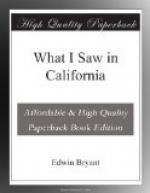“Sir,—I have the honour to inform you that, accompanied by Lieut. W.T. Sherman, 3rd Artillery, A.A.A. General, I started on the 12th of June last to make a tour through the northern part of California. We reached San Francisco on the 20th, and found that all, or nearly all, its male inhabitants had gone to the mines. The town, which a few months before was so busy and thriving, was then almost deserted. Along the whole route mills were lying idle, fields of wheat were open to cattle and horses, houses vacant, and farms going to waste.
“On the 5th we arrived in the neighbourhood of the mines, and proceeded twenty-five miles up the American Fork, to a point on it now known as the Lower Mines, or Mormon Diggings. The hill sides were thickly strewn with canvas tents and bush-harbours; a store was erected, and several boarding shanties in operation. The day was intensely hot, yet about 200 men were at work in the full glare of the sun, washing for gold—some with tin pans, some with close woven Indian baskets, but the greater part had a rude machine known as the cradle. This is on rockers, six or eight feet long, open at the foot, and its head had a coarse grate, or sieve; the bottom is rounded, with small cleets nailed across. Four men are required to work this machine; one digs the ground in the bank close by the stream; another carries it to the cradle, and empties it on the grate; a third gives a violent rocking motion to the machine, whilst a fourth dashes on water from the stream itself. The sieve keeps the coarse stones from entering the cradle, the current of water washes off the earthy matter, and the gravel is gradually carried out at the foot of the machine, leaving the gold mixed with a heavy fine black sand above the first cleets. The sand and gold mixed together are then drawn off through auger holes into a pan below, are dried in the sun, and afterwards separated by blowing off the sand. A party of four men, thus employed at the Lower Mines, average 100 dollars a-day. The Indians, and those who have nothing but pans or willow baskets, gradually wash out the earth, and separate the gravel by hand, leaving nothing but the gold mixed with sand, which is separated in the manner before described. The gold in the Lower Mines is in fine bright scales, of which I send several specimens.
“As we ascended the south branch of the American fork, the country became more broken and mountainous, and twenty-five miles below the lower washings the hills rise to about 1000 feet above the level of the Sacramento Plain. Here a species of pine occurs, which led to the discovery of the gold. Captain Sutter, feeling the great want of lumber, contracted in September last with a Mr. Marshall to build a saw-mill at that place. It was erected in the course of the past winter and spring—a dam and race constructed; but when the water was let on the wheel, the tail race was found to be too narrow to permit the water to escape with sufficient rapidity.




